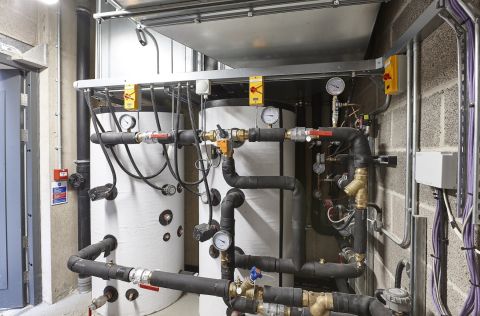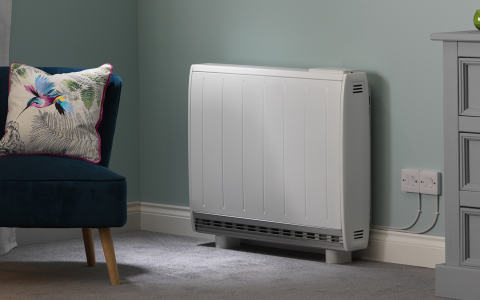
Which technologies are the most viable to deliver the decarbonisation of heating?

We should first consider how the carbon factor of electricity has recently changed when considering the decarbonisation of heat and its electrification. The SAP methodology offers an overview of the carbon and primary energy factors evolution.
The graph below shows SAP’s recognition of how electricity has decarbonised over time by 73.8%, and now has the lowest carbon factor of electricity, natural gas, and oil. Although the primary energy factor for electricity is still relatively high, this will reduce over time as more renewables feed into the grid. The opposite will be true of gas and oil as they become scarcer and harder to extract in the future.

The updated energy and emissions projections 2019 published by the Department for Business, Energy and Industrial Strategy, predict that by 2040, 83% of all UK energy will come from low carbon generation. This confirms that properties that implement electrified solutions and low carbon technologies today will reap benefits in the future.
What impact can hybrid solutions have on the decarbonisation of heating today?
Innovative heat pump technologies and heat networks are key low carbon heating technologies that can be specified today. However, the choice of technology should reflect the specific requirements of a project. Unfortunately, there isn’t a one-size-fits-all solution. Small properties may be better suited to a hybrid solution than a full heat pump system. Existing properties may benefit from a mix of technologies that include measures such as insulation, hot water heat pumps and direct acting panel heaters. Larger residential developments that are at risk of overheating could suit the specification of ambient networks. To ensure the selection of the right solution for each development, the industry would benefit from legislation that sets targets but remains largely technology agnostic.
Remaining impartial or indifferent about technology would help to increase the specification of hybrid solutions if they can bring appropriate project benefits. A hybrid heating solution is not limited to a heat pump/gas boiler combination. It describes any combination of technologies to provide hot water, space heating and comfort cooling. By combining technologies, a dwelling can utilise a cross section of benefits.
A good example is a hybrid system that utilises a low carbon Edel Hot Water Heat Pump to provide hot water, the highest energy load service. This allows complete freedom for specifying space heating and provides greater design flexibility. A notional hybrid system incorporating the Edel Hot Water Heat Pumps was modelled by Glen Dimplex Heating & Ventilation (GDHV) in SAP 10.1 following the Future Homes Standard consultation. For wider scope, the modelling extended to both houses and apartments. The aim was to illustrate the costs and benefits of the hybrid system. In addition, the modelling shows how compliance can be achieved using a mix of complementary technologies, including the following GDHV products:
- Electric panel heaters - direct-acting wall-mounted electric radiators
- Edel Hot Water Heat Pump - an air source heat pump that produces renewable hot water for a dwelling
- Mechanical ventilation, including mechanical ventilation with heat recovery (MVHR)
The modelling highlights the advantages that the specification of Edel Hot Water Heat Pumps can bring to a development in conjunction with a wide variety of technologies. We should also consider the importance of the effects the specification of hybrid systems may have on the electricity grid.

Can flexible energy storage technology support wider specification of low carbon technologies?
Electrification of heat in buildings is likely to create a load that correlates closely with external temperature. When temperatures drop, supply capacity could quickly be reached. To overcome this challenge, technologies such as High Heat Retention Storage Heating, hot water storage, and other flexible energy storage solutions can help create a smart-controlled reserve of energy in homes. These reserves can be used to supply energy for a heat pump solution when it is needed.
Focusing on continually increasing the grid peak capacity could risk potential unstable connections. By increasing the flexibility of the grid through the specification of flexible energy storage technologies, we can match supply and demand and maximise use of increasingly renewable (and therefore variable) grid energy. This would provide the industry with a platform from which to accelerate the specification of low carbon and electrified solutions.
The role of ambient networks in the low carbon economy of the future
Distribution heat losses can significantly decrease the efficiency of traditional centralised high temperature heating solutions in large scale residential and mixed use buildings. The heat loss in a modern building with thermally efficient envelopes can cause overheating in corridors and communal areas that may require additional mechanical ventilation.
This is where ambient networks are ideal for new developments. The Zeroth Energy System is a network of water-to-water in apartment heat pumps, connected by an ambient loop that runs at 25°C. The system was designed with the cooperation of leading building developers. The collaborative approach addressed the industry’s need for solutions that help increase energy efficiency and reduce the risk of overheating in residential apartments.
The system delivers low carbon hot water, heating, and comfort cooling through one system. When modelled in SAP2012 with an air source heat pump, the system achieved an efficiency of over 300%. The application of plant technology is flexible. Air source heat pumps can be replaced with a connection to a district heating network if required. Specification of ambient networks enables electrification within cities whilst meeting the most stringent proposed targets in the Future Homes Standard consultation, and regional extension targets where present.
To discuss how low-carbon technology and complementary systems can be integrated with your residential development or retrofit project, and to find out more about low carbon energy strategies, contact the GDHV specialist team.











